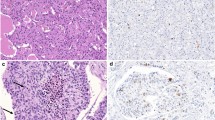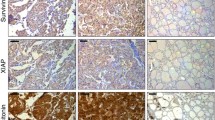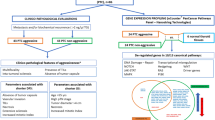Abstract
Unlike papillary thyroid carcinoma, medullary thyroid carcinoma is insensitive to adjuvant treatment with radioactive iodine. The clinical management of patients with advanced or metastatic disease remains challenging since no effective systemic adjuvant therapy is available. We aimed to identify markers of aggressive disease and novel drugable protein targets that would provide systemic adjuvant treatment for patients with advanced medullary thyroid carcinoma. We therefore examined morphologic features of aggressive behavior and the expression of 41 proteins involved in apoptosis, cell cycle, angiogenesis, inflammation, cell adhesion, tumor-specific markers, and WNT, SHH, and AKT pathways using tissue microarray from 23 patients with medullary thyroid carcinoma. Protein expression was determined using computerized image analysis software. Statistical analysis was carried out to correlate clinical data with the average score for each marker. Angioinvasion proved to be the most reliable predictor of disease recurrence and death. The rate of angioinvasion was 43 %. All angioinvasive medullary thyroid carcinomas had locoregional and/or distant metastasis; 60 % of angioinvasive medullary thyroid carcinomas developed distant metastasis. We identified expression of several potentially important protein targets such as COX-1/2, Bcl-2a, Gst-π, Gli-1, Gli-2, Gli-3, and Bmi-1 that may be therapeutically targeted in medullary thyroid carcinoma. More importantly, the immunohistochemical profile of SSTRs in medullary thyroid carcinoma may also have clinical relevance for the administration of peptide receptor radionuclide treatment. Successful outcome of clinical trials directed against these novel targets would provide much needed systemic adjuvant treatment for patients with advanced medullary thyroid carcinoma, and our data suggest the possibility of stratifying patients who are likely to require adjuvant therapy before their burden of disease precludes successful therapeutic effect.


Similar content being viewed by others
References
DeLellis RA, Lloyd RV, Heitz PU, editors. World Health Organization Classification of Tumours. Pathology and genetics of tumours of endocrine organs. IARC Press: Lyon, 2004.
Mete O, Asa SL. Composite medullary and papillary thyroid carcinoma in a patient with MEN 2B: Case report and review of c-cell lesions of the thyroid. Pathol Case Rev 14:208–13, 2009.
Ameur N, Lacroix L, Roucan S, et al. Aggressive inherited and sporadic medullary thyroid carcinomas display similar oncogenic pathways. Endocr Relat Cancer 16:1261–72, 2009.
Moley JF, Fialkowski EA Evidence-based approach to the management of sporadic medullary thyroid carcinoma. World J Surg 31:946–56, 2007.
Roman S, Lin R, Sosa JA. Prognosis of medullary thyroid carcinoma: demographic, clinical, and pathologic predictors of survival in 1252 cases. Cancer 107:2134–42, 2006.
Cupisti K, Wolf A, Raffel A, et al. Long-term clinical and biochemical follow-up in medullary thyroid carcinoma: a single institution’s experience over 20 years. Ann Surg 246:815–21, 2007.
Faik Erdogan M, Gursoy A, Erdogan G, Kamel N. Radioactive iodine treatment in medullary thyroid carcinoma. Nucl Med Commun 27:359–62, 2006.
Fialkowski EA, Moley JF. Current approaches to medullary thyroid carcinoma, sporadic and familial. J Surg Oncol 94:737–47, 2006.
van Veelen W, de Groot JW, Acton DS, et al. Medullary thyroid carcinoma and biomarkers: past, present and future. J Intern Med 266:126–40, 2009.
Schlumberger M, Carlomagno F, Baudin E, Bidart JM, Santoro M. New therapeutic approaches to treat medullary thyroid carcinoma. Nat Clin Pract Endocrinol Metab 4:22–32, 2008.
Ball DW. Medullary thyroid cancer: therapeutic targets and molecular markers. Curr Opin Oncol 19:18–23, 2007.
Carlomagno F, Santoro M. Identification of RET kinase inhibitors as potential new treatment for sporadic and inherited thyroid cancer. J Chemother 16:49–51, 2004.
Kodama Y, Asai N, Kawai K, et al. The RET proto-oncogene: a molecular therapeutic target in thyroid cancer. Cancer Sci 96:143–8, 2005.
Putzer BM, Drosten M. The RET proto-oncogene: a potential target for molecular cancer therapy. Trends Mol Med 10:351–7, 2004.
Gupta-Abramson V, Troxel AB, Nellore A, et al. Phase II trial of Sorafenib in advanced thyroid cancer. J Clin Oncol 26:4714–9, 2008.
Cohen EE, Rosen LS, Vokes EE, et al. Axitinib is an active treatment for all histologic subtypes of advanced thyroid cancer: results from a phase II study. J Clin Oncol 26:4708–13, 2008.
Wells S, You YN, Lakhani V, et al. A phase II trial of ZD6474 in patients with hereditary metastatic medullary thyroid cancer. J Clin Oncol (Meeting Abstracts) 24:5553, 2006.
Carlomagno F, Guida T, Anaganti S, et al. Disease associated mutations at valine 804 in the RET receptor tyrosine kinase confer resistance to selective kinase inhibitors. Oncogene 23:6056–63, 2004.
Plaza-Menacho I, Mologni L, Sala E, et al. Sorafenib functions to potently suppress RET tyrosine kinase activity by direct enzymatic inhibition and promoting RET lysosomal degradation independent of proteasomal targeting. J Biol Chem 282:29230–40, 2007.
Carlomagno F, Anaganti S, Guida T, et al. BAY 43–9006 inhibition of oncogenic RET mutants. J Natl Cancer Inst 98:326–34, 2006.
Juweid M, Sharkey RM, Behr T, et al. Radioimmunotherapy of medullary thyroid cancer with iodine-131-labeled anti-CEA antibodies. J Nucl Med 37:905–11, 1996.
Juweid M, Sharkey RM, Behr T, et al. Targeting and initial radioimmunotherapy of medullary thyroid carcinoma with 131I-labeled monoclonal antibodies to carcinoembryonic antigen. Cancer Res 55:5946s–51s, 1995.
Juweid ME, Hajjar G, Swayne LC, et al. Phase I/II trial of (131)I-MN-14F(ab)2 anti-carcinoembryonic antigen monoclonal antibody in the treatment of patients with metastatic medullary thyroid carcinoma. Cancer 85:1828–42, 1999.
Chatal JF, Campion L, Kraeber-Bodere F, et al. Survival improvement in patients with medullary thyroid carcinoma who undergo pretargeted anti-carcinoembryonic-antigen radioimmunotherapy: a collaborative study with the French Endocrine Tumor Group. J Clin Oncol 24:1705–11, 2006.
Mete O, Asa SL. Pathological definition and clinical significance of vascular invasion in thyroid carcinomas of follicular epithelial derivation. Mod Pathol 24:1545–52, 2011.
Schlumberger MJ, Elisei R, Bastholt L, et al. Phase II study of safety and efficacy of motesanib in patients with progressive or symptomatic, advanced or metastatic medullary thyroid cancer. J Clin Oncol 27:3794–801, 2009.
Kurzrock R, Sherman SI, Ball DW, Forastiere AA, Cohen RB, et al. Activity of XL184 (Cabozantinib), an oral tyrosine kinase inhibitor, in patients with medullary thyroid cancer. J Clin Oncol 29:2660–66, 2011.
Bass MB, Sherman SI, Schlumberger MJ, Davis MT, Kivman L, et al. Biomarkers as predictors of response to treatment with motesanib in patients with progressive advanced thyroid cancer. J Clin Endocrinol Metab 95:5018–27, 2010.
Sharafinski ME, Ferris RL, Ferrone S, Grandis JR. Epidermal growth factor receptor targeted therapy of squamous cell carcinoma of the head and neck. Head Neck 32:1412–21, 2010.
Quidville V, Segond N, Tebbi A, et al. Anti-tumoral effect of a celecoxib low dose on a model of human medullary thyroid cancer in nude mice. Thyroid 19:613–21, 2009.
Goto M, Mitra RS, Liu M, et al. Rap1 stabilizes beta-catenin and enhances beta-catenin-dependent transcription and invasion in squamous cell carcinoma of the head and neck. Clin Cancer Res 16:65–76, 2010.
Asa SL. Pancreatic endocrine tumors. Mod Pathol Suppl 2: S66-77, 2011.
Zhu CQ, Shih W, Ling CH, Tsao MS. Immunohistochemical markers of prognosis in non-small cell lung cancer: a review and proposal for a multiphase approach to marker evaluation. J Clin Pathol 59:790–800, 2006.
Masuko Katoh, M Katoh. WNT Signaling Pathway and stem cell signaling network. Clin Cancer Res 13:4042–5, 2007.
Weinberger PM, Adam BL, Gourin CG, et al. Association of nuclear, cytoplasmic expression of galectin-3 with beta-catenin/Wnt-pathway activation in thyroid carcinoma. Arch Otolaryngol Head Neck Surg 133:503–10, 2007.
Cotter TG. Apoptosis and cancer: the genesis of a research field. Nat Rev Cancer 9:501–7, 2009.
Kang MH, Reynolds CP. Bcl-2 inhibitors: targeting mitochondrial apoptotic pathways in cancer therapy. Clin Cancer Res 15:1126–32, 2009.
Mitsiades CS, Hayden P, Kotoula V, et al. Bcl-2 overexpression in thyroid carcinoma cells increases sensitivity to Bcl-2 homology 3 domain inhibition. J Clin Endocrinol Metab 92:4845–52, 2007.
Paik PK, Rudin CM, Brown A, et al. A phase I study of obatoclaxmesylate, a Bcl-2 antagonist, plus topotecan in solid tumor malignancies. Cancer Chemother Pharmacol 66:1079–85, 2010.
Thévenin AF, Zony CL, Bahnson BJ, Colman RF. GST pi modulates JNK activity through a direct interaction with JNK substrate, ATF2. Protein Sci 20:834–48, 2011.
Edelman MJ. Novel cytotoxic agents for non-small cell lung cancer. J Thorac Oncol 1:752–5, 2006.
Brunner M, Thurnher D, Pammer J, et al. Expression of hedgehog signaling molecules in Merkel cell carcinoma. Head Neck 32:333–40, 2009.
Peukert S, Miller-Moslin K. Small-molecule inhibitors of the hedgehog signaling pathway as cancer therapeutics. Chem Med Chem 5:500–12, 2010.
Sánchez-Beato M, Sánchez E, González-Carreró J, et al. Variability in the expression of polycomb proteins in different normal and tumoral tissues. A pilot study using tissue microarrays. Mod Pathol 19:684–94, 2006.
Vormittag L, Thurnher D, Geleff S, et al. Co-expression of Bmi-1 and podoplanin predicts overall survival in patients with squamous cell carcinoma of the head and neck treated with radio(chemo)therapy. Int J Radiat Oncol Biol Phys 1;73:913–8, 2009.
Reinisch CM, Uthman A, Erovic BM, Pammer J. Expression of BMI-1 in normal skin and inflammatory and neoplastic skin lesions. J Cutan Pathol 34:174–80, 2007.
Venkataraman S, Alimova I, Fan R, Harris P, Foreman N, Vibhakar R. MicroRNA 128a increases intracellular ROS level by targeting Bmi-1 and inhibits medulloblastoma cancer cell growth by promoting senescence. PLoS One 5:e10748, 2010.
Yu Q, Su B, Liu D, et al. Antisense RNA-mediated suppression of Bmi-1 gene expression inhibits the proliferation of lung cancer cell line A549. Oligonucleotides 17:327–35, 2007.
Godlewski J, Nowicki MO, Bronisz A, et al. Targeting of the Bmi-1 oncogene/stem cell renewal factor by microRNA-128 inhibits glioma proliferation and self-renewal. Cancer Res 68:9125–30, 2008.
Mendelsohn G, Wells SA Jr, Baylin SB. Relationship of tissue carcinoembryonic antigen and calcitonin to tumor virulence in medullary thyroid carcinoma. An immunohistochemical study in early, localized, and virulent disseminated stages of disease. Cancer 54:657–62, 1984.
Ezzat S, Huang P, Dackiw A, Asa SL. Dual inhibition of RET and FGFR4 restrains medullary thyroid cancer cell growth. Clin Cancer Res 11:1336–41, 2005.
Gulenchyn KY, Yao X, Asa SL, Singh S, Law C 2012 Radionuclide therapy in neuroendocrine tumours: a systematic review. Clin Oncol (R Coll Radiol) ;24(4):294–308, 2012.
Iten F, Müller B, Schindler C, et al. Response to [90Yttrium-DOTA]-TOC treatment is associated with long-term survival benefit in metastasized medullary thyroid cancer: a phase II clinical trial. Clin Cancer Res 13:6696–702, 2007.
Acknowledgment
The preliminary results of this paper were presented in part at the American Thyroid Association Meeting, October 26–29, 2011, Indian Wells, California, USA.
Disclosure/Conflict of Interest
All authors declare no conflict of interest.
Author information
Authors and Affiliations
Corresponding author
Rights and permissions
About this article
Cite this article
Erovic, B.M., Kim, D., Cassol, C. et al. Prognostic and Predictive Markers in Medullary Thyroid Carcinoma. Endocr Pathol 23, 232–242 (2012). https://doi.org/10.1007/s12022-012-9225-8
Published:
Issue Date:
DOI: https://doi.org/10.1007/s12022-012-9225-8




